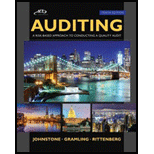
Auditing: A Risk Based-Approach to Conducting a Quality Audit
10th Edition
ISBN: 9781305080577
Author: Karla M Johnstone, Audrey A. Gramling, Larry E. Rittenberg
Publisher: South-Western College Pub
expand_more
expand_more
format_list_bulleted
Question
Chapter 6, Problem 58RSCQ
To determine
Introduction: Auditing means the inspection of financial accounts of the company to determine if the records are accurate as per the rules and regulations of accounting or not. There are two types of auditors, i.e., internal auditors and external auditors, that carry out the
To state: The constituents that effect sample sizes while testing controls.
Expert Solution & Answer
Want to see the full answer?
Check out a sample textbook solution
Students have asked these similar questions
An auditor typically selects samples when testing controls. What are some factors that affect the sample sizes used when testing controls?
The type of sampling most frequently used by auditors during their study of internal control is referred to asa. Attributes sampling.b. Control sampling.c. Monetary unit sampling.d. Variables sampling.
In determining the tolerable deviation rate for a test of controls, the auditors consider:
Their planned assessed level of control risk.
The sample size.
The nature of the test.
The expected deviation rate in the population.
Chapter 6 Solutions
Auditing: A Risk Based-Approach to Conducting a Quality Audit
Ch. 6 - Prob. 1TFQCh. 6 - Prob. 2TFQCh. 6 - Prob. 3TFQCh. 6 - Prob. 4TFQCh. 6 - Prob. 5TFQCh. 6 - Prob. 6TFQCh. 6 - Prob. 7TFQCh. 6 - Prob. 8TFQCh. 6 - Prob. 9TFQCh. 6 - Prob. 10TFQ
Ch. 6 - Prob. 11TFQCh. 6 - Prob. 12TFQCh. 6 - Prob. 13TFQCh. 6 - Prob. 14TFQCh. 6 - Prob. 15TFQCh. 6 - Prob. 16TFQCh. 6 - Prob. 17TFQCh. 6 - Prob. 18TFQCh. 6 - Prob. 19TFQCh. 6 - Prob. 20TFQCh. 6 - Prob. 21MCQCh. 6 - Prob. 22MCQCh. 6 - Prob. 23MCQCh. 6 - Prob. 24MCQCh. 6 - Prob. 25MCQCh. 6 - Prob. 26MCQCh. 6 - Prob. 27MCQCh. 6 - Prob. 28MCQCh. 6 - Prob. 29MCQCh. 6 - Prob. 30MCQCh. 6 - Prob. 31MCQCh. 6 - Prob. 32MCQCh. 6 - Prob. 33MCQCh. 6 - Prob. 34MCQCh. 6 - Prob. 35MCQCh. 6 - Prob. 36MCQCh. 6 - Prob. 37MCQCh. 6 - Prob. 38MCQCh. 6 - Prob. 39MCQCh. 6 - Prob. 40MCQCh. 6 - Prob. 41RSCQCh. 6 - Prob. 42RSCQCh. 6 - Prob. 43RSCQCh. 6 - Prob. 44RSCQCh. 6 - Refer to Exhibit 6.2 and describe the differences...Ch. 6 - Prob. 46RSCQCh. 6 - Prob. 48RSCQCh. 6 - Prob. 49RSCQCh. 6 - Prob. 50RSCQCh. 6 - Prob. 51RSCQCh. 6 - Prob. 52RSCQCh. 6 - Prob. 53RSCQCh. 6 - Indicate how the auditor could use substantive...Ch. 6 - Prob. 55RSCQCh. 6 - Prob. 56RSCQCh. 6 - Prob. 57RSCQCh. 6 - Prob. 58RSCQCh. 6 - Prob. 59RSCQCh. 6 - Prob. 60RSCQCh. 6 - Prob. 61RSCQCh. 6 - Prob. 62RSCQCh. 6 - Prob. 63RSCQCh. 6 - Prob. 64RSCQCh. 6 - Prob. 65RSCQCh. 6 - Prob. 66RSCQCh. 6 - Prob. 67RSCQCh. 6 - Prob. 68RSCQCh. 6 - Prob. 69FFCh. 6 - Prob. 70FFCh. 6 - Prob. 71FFCh. 6 - Prob. 72FFCh. 6 - MINISCRIBE (LO 1, 2) As reported in the Wall...
Knowledge Booster
Recommended textbooks for you
 Auditing: A Risk Based-Approach to Conducting a Q...AccountingISBN:9781305080577Author:Karla M Johnstone, Audrey A. Gramling, Larry E. RittenbergPublisher:South-Western College Pub
Auditing: A Risk Based-Approach to Conducting a Q...AccountingISBN:9781305080577Author:Karla M Johnstone, Audrey A. Gramling, Larry E. RittenbergPublisher:South-Western College Pub Auditing: A Risk Based-Approach (MindTap Course L...AccountingISBN:9781337619455Author:Karla M Johnstone, Audrey A. Gramling, Larry E. RittenbergPublisher:Cengage Learning
Auditing: A Risk Based-Approach (MindTap Course L...AccountingISBN:9781337619455Author:Karla M Johnstone, Audrey A. Gramling, Larry E. RittenbergPublisher:Cengage Learning

Auditing: A Risk Based-Approach to Conducting a Q...
Accounting
ISBN:9781305080577
Author:Karla M Johnstone, Audrey A. Gramling, Larry E. Rittenberg
Publisher:South-Western College Pub

Auditing: A Risk Based-Approach (MindTap Course L...
Accounting
ISBN:9781337619455
Author:Karla M Johnstone, Audrey A. Gramling, Larry E. Rittenberg
Publisher:Cengage Learning